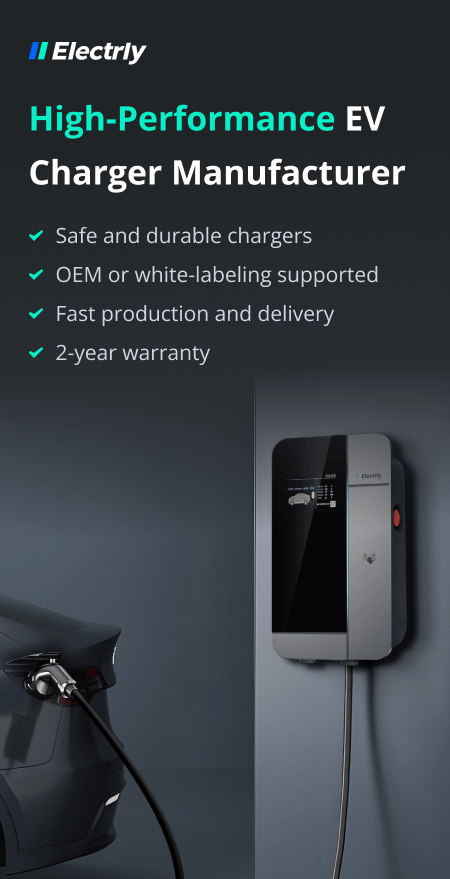If you are new to the world of electric vehicles or are considering purchasing one, it is vital to understand the charging infrastructure.
The use of charging stations is crucial to ensuring that you can easily complete your journey without worrying about running out of power.
In this blog post, Electrly will explore the different types of charging stations and equipment available for electric vehicles. By the end of this post, you'll have a better understanding of EV charging stations.
EV Infrastructure: What Is It?
EV infrastructure refers to all the equipment, components, charging stations, and electrical grid connections needed to support the charging and operation of electric vehicles. It includes charging points installed along commonly used routes to ensure that EVs have access to charging capabilities on the road, in much the same way as fossil fuel vehicles have access to gas stations.
Deploying adequate EV charging capacity requires robust planning and dedicated electrical infrastructure to ensure that it meets the needs of a growing number of drivers without overwhelming the power distribution grid.
Increasing the number of charging locations must coincide with an increase in electrical grid capacity to meet infrastructure demand.
In the future, EV infrastructure will include the wider deployment of bi-directional technology, which enables users to plug in their EVs to their homes or the electricity grid to provide local power supply or network balancing.
EV Charging Station Terminology Explained
The EV charging industry has agreed to a common standard that is known as the Open Charge Point Interface (OCPI) protocol, which aims to simplify and standardize terminology so that the market can grow in an orderly way.
There is a three-part hierarchy for car charging stations: location, EV supply equipment (EVSE) port, and connector.
EV Charging Location
A charging station location refers to a site with one or more ports, such as a parking lot at a shopping mall, hotel, restaurant, and so on.
EVSE Ports
EVSE ports supply electricity to one EV at a time, although they can have more than one connector. The unit surrounding an EVSE port is known as a charging port and can contain more than one port.
EV Connectors / EV Plugs
A connector is the end of the cable used to connect the EVSE port with the port on the EV that receives power, which is called the vehicle inlet. There are multiple types of EV plugs, such as Combined Charging System (CCS) and CHAdeMO.
What Constitutes an Electric Vehicle Charging Station?
An electric vehicle (EV) charging station has several components, including a charging unit, power storage system, power grid connection, facility meter (such as MID meter), network operating center, and other necessary components.
The charging unit is responsible for managing the flow of electricity from the power grid to the EV's battery.
The power storage system of an EV charging station consists of three main units: the battery, the power conversion system, and the software.
The batteries used in electric car charging stations are typically lithium-ion batteries, which include cells, packs, and a battery management system (BMS) to manage the power charge and discharge.
The power conversion system includes an inverter, enclosure, and thermal management to maintain a stable battery temperature.
EV charging software is a key component that helps manage the electric chargers, providing operators with connection and monitoring capabilities, automatic fault detection, live meter display, billing and payment information, cost tracking, user management, and other features.
EV charging stations can operate as standalone systems or feature different types of communication equipment for external communication, such as Ethernet, WiFi, 3G/4G, Bluetooth, near-field communication (NFC), or even dry contact. Public charging stations may also include authentication equipment, such as a radio-frequency identification (RFID) reader, to ensure that only authorized users can access the charging station.
Overall, an EV charging station is a complex system that requires various components to work together seamlessly to provide efficient and safe charging for electric vehicles.
Different Types of EV Charging Stations
EV charging equipment is classified based on the rate at which it charges batteries. There are three main types of charging stations with different charging levels: AC Level 1, AC Level 2, and DC fast chargers (Level 3).
AC Level 1
Level 1 chargers use a 120-volt (V) electrical outlet and can be plugged into any household power socket. They typically provide 3-5 miles of driving range per hour of charging, so they are most suitable for overnight charging.
AC Level 2
Level 2 chargers use a 240V electrical outlet. They typically provide 10-20 miles of driving range per hour of charging, so they can charge a vehicle much faster than a Level 1 EV charger. Level 2 chargers are often used at public charging stations or homes that have installed an upgraded electrical panel for their EV charging point.
DC Fast Charging
DC fast chargers are the fastest type of electric charging station available, using 480V direct current power. They can charge an EV in around 30 minutes, which means providing up to 10 miles of range per minute of charging time, making them ideal for public charging stations or long-distance travel.
How Do I Find EV Charging Stations Near Me?
Electric vehicle charging stations are increasingly located in a range of sites, from parking lots to shopping malls, hotels, gas stations, and street corners. Taking longer journeys in your EV can require some planning to make sure you have access to charging stations along your route.
If you are on the road or want to find a location in advance to charge your EV, you can navigate our handy electric car charging stations map to find one nearby.

